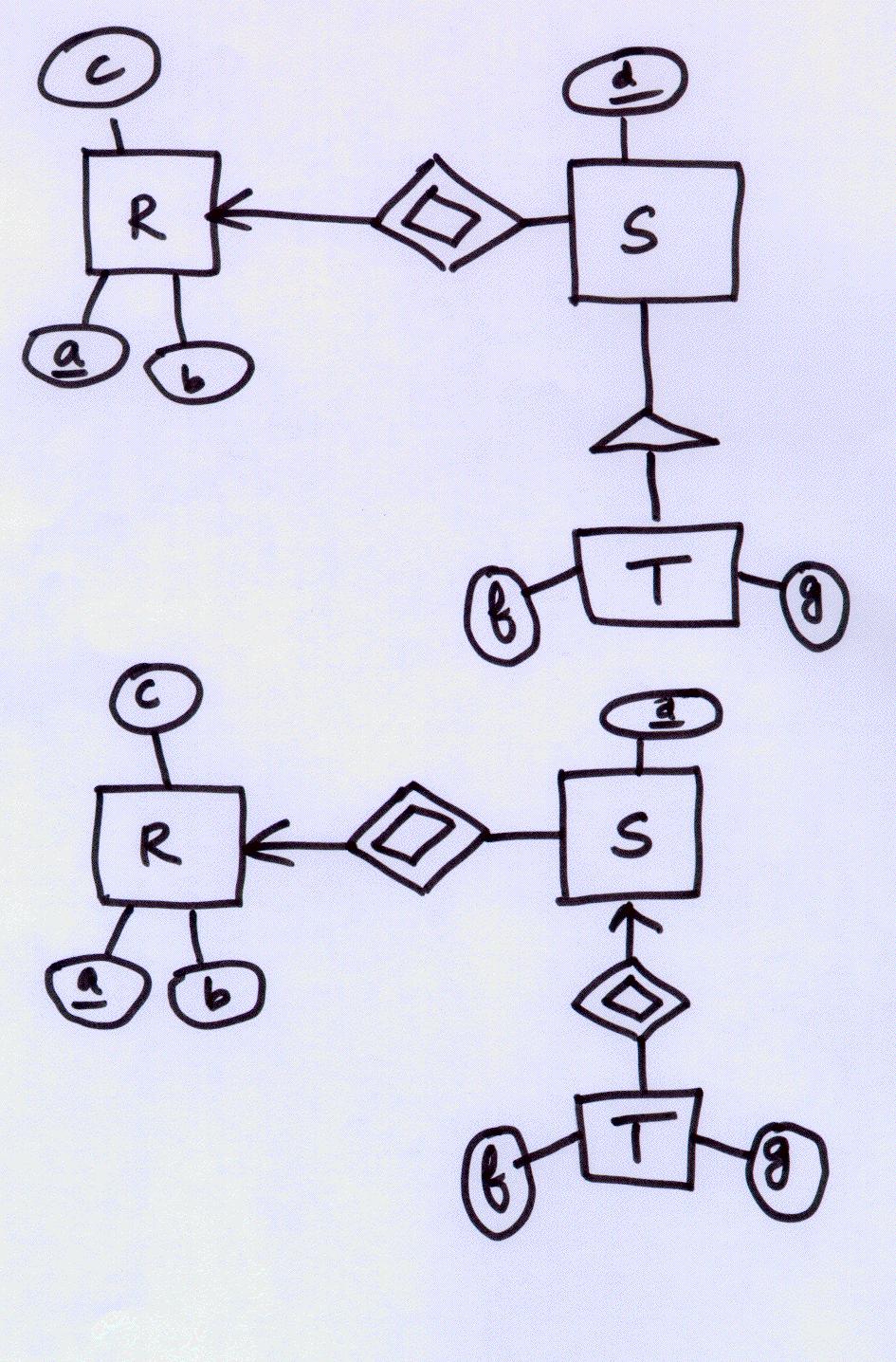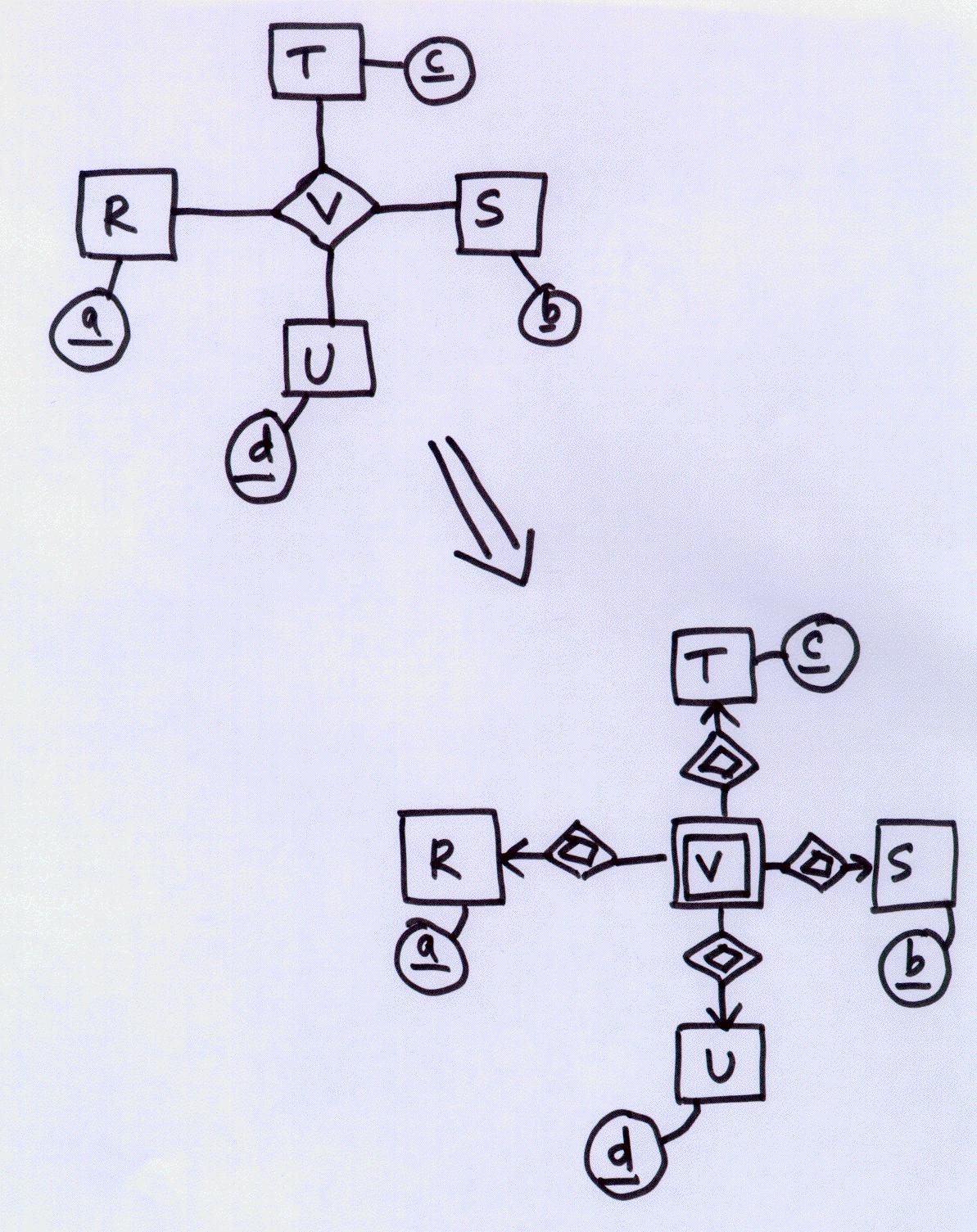(In the second diagram, as in the first, the attribute for S is a "d"; the drawing may not be clear when printed)

class R
(key a)
{
attribute integer a;
relationship Set<V> RtoV
inverse V::VtoR;
};
class S
(key b)
{
attribute integer b;
relationship Set<V> StoV
inverse V::VtoS;
};
class T
(key c)
{
attribute integer c;
relationship Set<V> TtoV
inverse V::VtoT;
};
class U
(key d)
{
attribute integer d;
relationship Set<V> UtoV
inverse V::VtoU;
};
class V
(key VtoR VtoS VtoT VtoU)
{
relationship R VtoR
inverse R::RtoV
relationship S VtoS
inverse S::StoV
relationship T VtoT
inverse T::TtoV
relationship U VtoU
inverse U::UtoV
};
V is the type of class that would have been obtained via a pushed-out E/R diagram
(i.e., V would be a multiway relationship between R, S, T, and U; after the
push-out it would become an entity set with
many-one relationships to each of the other four entity sets). Recall that
we cannot have multiway relationships in ODL and so we would have employed the
push-out construction to render the diagram in ODL. In E/R terms, V would be a weak set since it is dependent on all of R, S, and T, and U to contribute towards its key. Recall that one of the main causes of weak sets is the push-out construction. In fact, we can go one step further and also say that not only is V resulting from the push-out of a multiway relationship, but that the multiway must have been many-many in all directions (i.e., it doesn't have any arrows). This is because all four attributes are used to form the key for V. If there was at least one arrow, there would have been a key possible with only three attributes (not four). The question indicates that all four attributes make up the key for V, so we can make this inference (see diagram below).

Full points if you gave the correct ODL code and also made the inference about the push-out of a many-many-many-many multiway relationship. 8 points if you only give the ODL code, without the inference. 9 points if you give the ODL code, make the inference about the push-out, but not about the many-many-many multiway relationship.
Another way to calculate this is as follows: The number of superkeys that have A1 is 2^(n-1). The number of superkeys that have A2 is 2^(n-1). If we add them, we get 2*2^(n-1). But we would have counted some of these superkeys twice. The precise number we double-counted are the ones that have both A1 and A2. So, we have to subtract these superkeys, of which there are 2^(n-2) (since they have both A1 and A2 in them). So, the final answer is: 2*2^(n-1) - 2^(n-2), or just 2^n - 2^(n-2).
In case you haven't figured it out, this is just the same as 3*2^(n-2). This is because 2^n is equal to 4*2^(n-2).
Closure of A = {A,D}
Closure of B = {B}
Closure of C = {C}
Closure of AB = {A,B,D,E}
Closure of AC = {A,C,D,E,B} This gives AC->B
Closure of BC = {B,C}
Thus, the only FD we can state for S is AC->B.- We first need to systematically determine all the FDs that hold in R.
This is done by computing the closures of all subsets of R. If you
do this meticulously, you will notice that you will get an additional FD
BE->C.
The FDs that are in violation of BCNF are all of them (!), since they
do not have a superkey on the left. In other words, the violating FDs are:
AB->C DE->C B->D BE->C
- Let us try to decompose it by the first FD: AB->C. We get {A,B,C},{A,B,D,E}.
In {A,B,C}, the only FD that holds in AB->C. Since AB is the key, there is
no violation of BCNF. In {A,B,D,E}, the FD B->D is in violation of BCNF.
We decompose it further to obtain {B,D},{B,A,E}. Each of these
is in BCNF (why?). The final relations are
therefore {{A,B,C},{B,D},{A,B,E}}.
- All the original FDs are in violation of 3NF too, since in addition
to none of the left hand sides being a superkey, none of the right hand
sides has part of a key.
- Assume that we decompose by B->D. We get {{B,D},{B,A,C,E}}. In
the second schema AB->C, BE->C hold. The key is still {A,B,E}.
Both are in violation of 3NF. Lets decompose via AB->C. We get
{{A,B,C},{A,B,E}}. Each of these is in 3NF. The final schemas
are {{B,D},{A,B,C},{A,B,E}}.
A diligent student pointed out that this decomposition does not preserve dependencies (notice that BE->C and DE->C cannot be preserved without a complicated "joining" back of the relations), though we learnt in class that 3NF is good at preserving FDs. The actual algorithm for performing a dependency preserving decomposition is beyond the scope of this course. If interested, please meet the instructor. The itty-bitty-dirty fix to this problem is to add another schema {B,C,D,E} that helps us preserve both the FDs BE->C and DE->C. (In other words, before tuples are added to the other schemas, this schema will ensure that the FDs are preserved).
a1 b1 c1 a2 b1 c2Decomposing it, we get:
a1 b1 a2 b1and
b1 c1 b1 c2Joining them back gives, instead:
a1 b1 c1 a1 b1 c2 a2 b1 c1 a2 b1 c2i.e., we get two extra tuples. The decomposition is thus lossy. How did we arrive at this example? Notice how we did the decomposition. We performed it based on the assumption that either B->C or B->A holds. We have designed the example (cleverly) to ensure that both of these FDs
a1 b1 c1 a2 b2 c2 a3 b2 c2 a4 b1 c1If you started with the other FD, you will get a solution of a different type.
